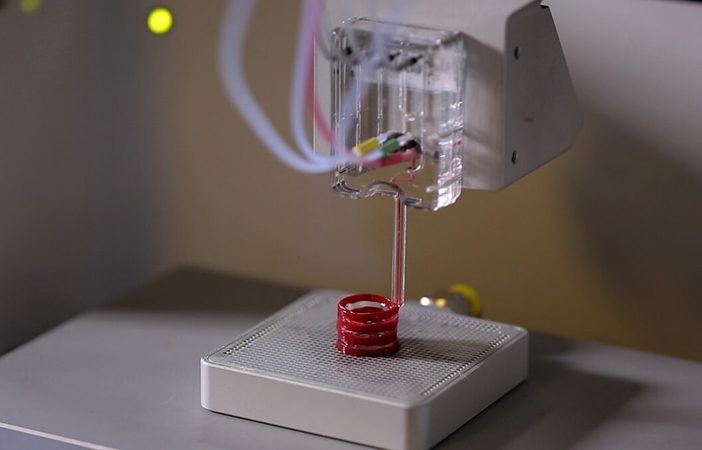Canadian 3D bioprinting firm Aspect Biosystems has unveiled a new partnership with the international diabetes research and advocacy organization JDRF.
As part of the deal, JDRF has agreed to back Aspect Biosystems’ bid to create novel 3D bioprinted tissues capable of treating those with type 1 diabetes. Specifically, the group is set to lend its expertise on the disease and contact book to the project, with the aim of accelerating its partner’s plans to give diabetics “insulin independence.”
“Together with JDRF, we are aligned on the mission to develop a curative therapy for the millions of patients around the world who are affected by type 1 diabetes,” said Tamer Mohamed, CEO of Aspect Biosystems. “This partnership will help advance our cutting-edge pancreatic tissue program and bring us a step closer to human trials.”

Aspect Biosystems’ RX1 platform
Since it was founded in 2013, Aspect Biosystems has set out to combine microfluidics and 3D bioprinting, as a means of advancing medical research and developing unique therapies for diseases. One of the main ways the firm has sought to achieve this is via its RX1 bioprinter, a system capable of switching between different cell types on the fly to enable the creation of heterogeneous tissues.
Over the last nine years, Aspect Biosystems has gained significant backing for its technology, closing a $20 million Series A funding round in early-2020, as well as establishing partnerships designed to deploy it within therapeutic applications.
Following its capital raise, for instance, the company launched a 3D bioprinting grant program, in which labs were encouraged to apply for access to its RX1 system. At the time, it was said that the initiative would see two research groups supplied with a bioprinter, starter kit and all the necessary training to operate them over six months, free of charge.
In the past, Aspect Biosystems has also partnered with a team at Maastricht University, to develop viable 3D bioprinted kidney tissues for medical testing purposes, and been selected to contribute to a $2.2 million cancer research project, which saw it work with Merck and GSK, in addition to McGill University’s Goodman Cancer Research Centre.

Bioprinting a remedy for diabetes
Unlike type 2 diabetes, developing the type 1 variant isn’t believed to be related to age or weight, and it’s theorized that it is actually caused by an autoimmune reaction in which the body attacks itself. As such, patients often develop the disease through no fault of their own, and with its triggers still not being fully understood, it is predicted that five million Americans will be diagnosed with it by 2050.
From what we do know, type 1 diabetes essentially inhibits patients’ ability to generate enough insulin to control the blood glucose levels in their bloodstreams. This, in turn, can cause those afflicted to develop fatigue, weight loss and blurred vision, and if left untreated, it can also lead to long-term blood vessel, nerve or organ damage.
Manufacturing on Demand
In order to manage their blood sugar levels, people with diabetes currently have to administer insulin via pump or injection, in what can be an invasive task. Although a number of alternative treatments are under R&D, with Readily3D even using a 3D bioprinted pancreas to test their efficacy, none have yet been rolled-out at scale.
Through its newly-announced collaboration with JDRF, however, Aspect Biosystems is now trying to change this, by ramping up the development of a 3D printed tissue therapy for treating type 1 diabetes. While the firm hasn’t revealed exactly how the treatment will work, it’s understood to be a cell-based implant that works to repair damaged organ functions, thus making patient insulin injections obsolete.
For its part, JDRF has committed to not only providing funding for the project but its “strategic support,” in a move that will provide Aspect Biosystems with access to its partner’s 52 years of diabetes expertise, helping to advance its future research.
“For more than 20 years, JDRF has been a leader in cell-based tissue therapy research for type 1 diabetes,” said Esther Latres, Assistant VP of Research at JDRF. “This funding partnership with Aspect Biosystems will support and continue scientific advancements in the field and undeniably take us closer to finding a cure.”

Advances in 3D printed therapies
Using not just 3D bioprinting but conventional 3D printing as well, researchers continue to make advances in the development of cures for all sorts of different diseases. Scientists at North Carolina State University, for example, have managed to create optimized 3D printed radiation antennas for cancer patients to wear during breast hyperthermia procedures.
In the world of 3D bioprinting, meanwhile, researchers at Lawrence Livermore National Laboratory, Duke University, and Texas A&M have created the first-ever living in-vitro aneurysm. By operating on the cellular mass outside the body, observing how it heals, and inputting their findings into computer models, the team believe it could be possible to develop patient-specific aneurysm treatments.
Similarly, back in 2020, a group of US and Germany-based researchers came up with a 3D bioprinted glioblastoma model, with the potential to further doctors’ understanding of how the cancer grows. Having created their vascularized tumor from human brain cells and biomaterials, the scientists were able to culture and attempt to treat it, while tracking the results using 3D imaging techniques.
* This article is reprinted from 3D Printing Industry. If you are involved in infringement, please contact us to delete it.
Author: Paul Hanaphy

Leave A Comment